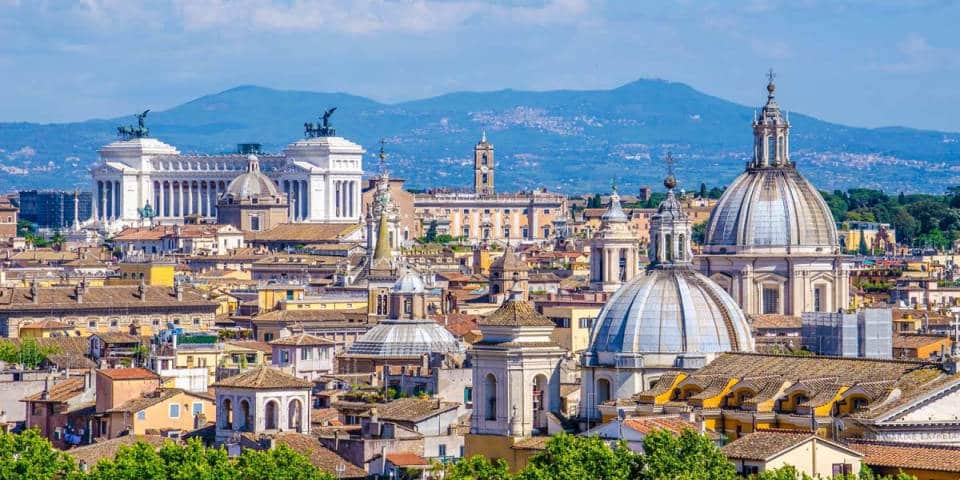

24849 views

Janiculum Hill (or Gianicolo) is the second tallest hill in Rome after Monte Mario. Though not in the list of famous seven Roman hills, you would be surprised to know that Janiculum Hill is the place where all romantic postcard pictures are usually taken.
If you want to immerse into authentic Roman atmosphere and possibly become a hero of a romantic postcard, this is definitely the place to go.
Contents
ToggleAs most of the locals say – Janiculum is the eights hill of Rome. At the moment of city construction, the hill was not part of the city line. Only afterwards, Janiculum was connected with the city through several bridges. Initially Janiculum hill was inhabited by Etruscans (ancient civilization of Italy), then there were Syrians and only after – Romans. Emperor Ancus Marcius was the one who incorporated the area into ancient Rome and further fortified it with the wall on its borders.
Starting from 17th century Janiculum was inhabited by the Roman noblemen, who actively invested in the construction of their villas. This, in turn, have considerably changed the image of the district. The most significant event in the history of Janiculum was the fight between the army of Garibaldi (Italian general and national hero) with the French army in 1849 that eventually led to the unification of Italy. Today, district holds an all-known name of Trastevere – one of the most vibrant and authentic Roman quartiers.
Note: Italian army continues tradition of daily canon fire at noon! You can come to Piazzale Garibaldi to see it
Following is the list of must-visit places and the instructions on how to get to the Janiculum hill.
In order to explore the whole district, tourists are suggested to start their journey from the highest point of the hill – the Garibaldi monument. The statue of General Garibaldi residing on a horse dates back to 1895. Right at the foot of the statue, there is an observation deck that opens up a splendid view on the domes of Roman buildings.
You might be quite surprised to see a lighthouse – Faro al Gianicolo that stands there form 1911. The lighthouse was a gift from Italians who immigrated to Argentina and is called the Manfredi Lighthouse after its creator Manredo Manfredi.
Moving on Janiculum hill, you can relax from the hustle and bustle of the big city in Botanical Garden (Orto Botanico). Located on the territory of ancient Villa Corsini, the Botanical Garden became a property of the Italian government in 1883. From that time on, extensive 12 ha gardens are open to visitors. By walking through the gardens, you can absorb the beauty of the scenery and aroma of the herbs.
On your way to Janiculum, you can see Fontana dell’Acqua Paola that is considered to be the predecessor of famous Trevi fountain (Fontana di Trevi). The construction of the fountain was commissioned by Pope Paul V in 1612. During the summer, tourists can not only observe the beautiful city view from the top, but also listen to numerous jazz concerts organized in front of fountain.
Next, you can make a quick stop by San Pietro in Montorio church. Todays’ church building is placed on top of the previous church of St. Peter’s built in 9th century. According to one source, this was the place of St. Peter’s crucifixion.
As we talked about earlier, the Trastevere area resides on Janiculum hill and is the most authentic of all Roman quartiers.
Although, just having walked through its tiny streets will tell you a lot of what the Roman quartier used to look like in the past, you might consider stopping by some of the most prominent points of Trastevere district
Considered to be one of the oldest Roman temples, the main structure of Basilica of Santa Maria in Trastevere (Basilica di Santa Maria in Trastevere) was laid in 340s. This is also the first Roman church dedicated to mother of Jesus – Maria. Today’s Basilica dates back to 12th century and was commissioned by Pope Innocent II. The church is famous for its beautiful mosaic interior.
If you want to get familiar with the life of local Romans in 18-19th centuries, you can visit Museum of Rome in Trastevere (Museo di Roma in Trastevere). There you will find sceneries from the life of Romans, depicting their clothes, household and culture.
You can get to Trastevere either by bus (H – departs from the main train station: Termini) or by tram (N8 – departs from piazza Venezia). Overall, Trastevere district is located not far from the city center, the only thing is to cross the Tiber river through the bridge (Ponte Sisto – brings you to piazza Trilussa).
Author: Kate Zusmann
This website uses cookies. For more info read the cookies policy
Rome.us © 2025. Created with love by Roman experts and guides.